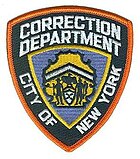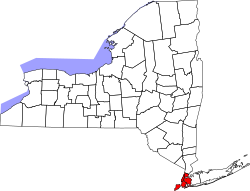New York City Department of Correction
| New York City Department of Correction | |
|---|---|
 | |
 Shield of the New York City Department of Correction | |
 Flag of the New York City Department of Correction | |
| Abbreviation | NYCD |
| Motto | New York's Boldest |
| Agency overview | |
| Formed | 1895 |
| Employees | 9,650 |
| Jurisdictional structure | |
| Operations jurisdiction | City of New York, United States |
 | |
| Map of New York City Department of Correction's jurisdiction | |
| Legal jurisdiction | New York State |
| Constituting instrument | |
| General nature |
|
| Operational structure | |
| Headquarters | East Elmhurst, Queens |
| Correction Officers | 8,563 |
| Commissioner responsible |
|
| Agency executive |
|
| Website | |
| Official Site | |
The New York City Department of Correction (NYCDOC) is the branch of the municipal government of New York City[1] responsible for the custody, control, and care of New York City's imprisoned population, housing the majority of them on Rikers Island.[2] It employs 8,563 uniformed officers and 1,400 civilian staff, has 543 vehicles,[3] and processes over 100,000 new inmates every year,[4] retaining a population of inmates of between 3,000 and 6,000.[3] Its nickname is New York's Boldest.[4] Its regulations are compiled in title 39 of the New York City Rules.
Previously located in Manhattan, the Department of Correction headquarters is now located in the Bulova building in East Elmhurst, Queens,[5][6] close to Rikers Island. The agency is headed by the Correction Commissioner, who is chosen and appointed by the Mayor of New York City.
History[]
The New York City Department of Correction was first founded as a separate entity in New York City in 1895 after a split from the Department of Public Charities and Correction.[2] Roosevelt Island, then called Blackwell's Island, was the main penal institution under the jurisdiction of the DOC until the 1930s when it was closed. The penal institutions moved to Rikers Island, which the city purchased for $180,000, where 10 prisons and 6,000 inmates are now held.[2]
Historians[who?] have not described the prison system of New York in the 19th century in a favorable light - with employment positions being awarded based on the spoils system and employees being characterized as largely corrupt. The Blackwell's Island penitentiary is described as having lax security, where prisoners were able to escape if they knew how to swim.[7]
In 1995, the New York City jail system was one of the most violent in the United States, averaging more than 100 stabbings and slashings per month. Between January 1995 and January 2002, the department achieved a 93% reduction in inmate on inmate violence as a result of a management system recognized by Harvard University's John F. Kennedy School of Government, called Total Efficiency Accountability Management System (TEAMS).[8] By 2007, the number of stabbings was reduced to 19, making that year the Department of Correction's safest on record, although the issue of underreporting of incidents has not been addressed.[4]
In 2009, former commissioner of both the Missouri and Arizona prison systems Dora Schriro was selected to head the department, with some citing a need in the department for a boost in morale.[9] Schriro was named in several federal court cases such as Schriro v. Smith and Schriro v. Summerlin. Schriro served with the United States Department of Homeland Security prior to coming to the Department.
Responsibilities[]
Correction officers are responsible for the care, control, custody, work performance and job training of inmates. Duties include:
- Inspecting facilities for safety and security, and safeguarding supplies and equipment.
- Supervising meals, recreation, and visitors.
- Maintaining logs.
- Interacting with inmates, and recommending medical and/or psychiatric referrals.
- Escorting and transporting inmates within and outside of the facility.[10]
Command structure[]
There are nine titles (referred to as ranks) in the New York City Department of Correction.
From highest to lowest, the uniformed ranks are:
| Title | Insignia |
|---|---|
| Chief of Department | |
| Bureau Chief / Deputy Chief | |
| Assistant Chief / Supervising Warden | |
| Warden | |
| Deputy Warden in Command | |
| Deputy Warden / Facility Administrative Chaplain | |
| Assistant Deputy Warden / Chaplain | |
| Captain | |
| Correction Officer/Correction Officer Investigator |
There are certain civilian leadership positions in the agency which have power equivalent to the high ranking uniformed personnel. If they outrank a present uniformed officer, they are saluted due to agency customs and courtesies.
From highest to lowest, the civilian leadership ranks are:
| Title | Insignia |
|---|---|
| Commissioner | |
| First Deputy Commissioner | |
| Deputy Commissioner | |
| Associate Commissioner | |
| Assistant Commissioner |
The Commissioner is the highest ranking official in the agency and is in command of all uniformed and civilian personnel.
Equipment and vehicles[]
Correction officers are trained in the use of a firearm, but are only armed on certain post assignments due to the potential threat of prisoners overpowering an officer. On duty firearm is provided (Smith & Wesson 5946 DAO) however should the member elect there is a list of authorized firearms such as Glock. For officers hired before March 1994, the model 10 & 64 revolvers are still used. Correction officers must be authorized by a chief and warden before they can carry off duty. Officers' options include their duty firearm and or Glock 26 for off duty use.[11]

The department uses numerous marked vehicles including Chevrolet Impalas, Ford vans, transport buses, firetrucks, and riot vehicles.[12][13]
Employee benefits[]
In 2018, the total salary for a correctional officer, including benefits, ranged from $46,261 to $99,073 (depending on years of service). Benefits include a uniform allowance, holiday pay, night shift compensation, longevity pay, paid sick days, paid vacation days, paid holidays, medical and dental compensation, and pension benefits. Officers also have an opportunity to work overtime.[14]
Facilities[]
Rikers Island is the main correctional facility.
Horizon Juvenile Center serves as the juvenile facility. The final juvenile inmates on Rikers Island were moved to Horizon in 2018.[15] The move was prompted by a law passed by New York state in 2017 requiring that juvenile inmates under 18 be housed separately from adults.[16]
Notable employees[]
- Mickey Marcus, Commissioner in 1940 - Would go on to serve in World War II with the United States Army and later join the Israeli Defense Force and be instrumental in leading their forces during that country's independence movement.
- Anna M. Kross Commissioner from 1953-1966. Developed the NYC Corrections R&D arm to research recidivism methods. She campaigned for legislation to treat addicts and alcoholics as people with medical rather than criminal conditions. Second woman to hold the position.
- Leo C. Zeferetti Former US Congressman
- Anthony S. Seminerio Former State Assemblyman
- Bernard Kerik, Served in the NYCDOC from 1994-2001, Kerik became Correction Commissioner after retiring from the NYPD as a detective.
- Soul singer Sharon Jones served as a corrections officer at Rikers Island.[17]
See also[]
- Corrections
- List of jail facilities in New York City
- List of law enforcement agencies in New York
- New York City Board of Correction
- New York State Department of Corrections and Community Supervision
- New York City Department of Probation
- Roosevelt Island
References[]
- ^ New York City Charter § 621; "There shall be a department of correction the head of which shall be the commissioner of correction."
- ^ Jump up to: a b c History of the DOC New York City Department of Correction, retrieved March 13, 2008
- ^ Jump up to: a b Facilities Overview Archived April 20, 2014, at the Wayback Machine New York City Department of Correction, retrieved March 13, 2008
- ^ Jump up to: a b c Press Release - January 6, 2008 New York City Department of Correction, available here retrieved March 13, 2008
- ^ "Contact Department of Correction". www1.nyc.gov. Retrieved November 28, 2020.
- ^ "Headquarters | Correction Officers' Benevolent Association, Inc". www.cobanyc.org. Retrieved November 28, 2020.
- ^ Timothy J. Gilfoyle (2006). A Pickpocket's Tale: The Underworld of Nineteenth-Century New York. W. W. Norton Company. ISBN 978-0393329896.
- ^ Drew, Christopher (November 8, 1999). "LOCKDOWN -- A special report.; An Iron Hand at Rikers Island Drastically Reduces Violence". Retrieved May 29, 2018 – via NYTimes.com.
- ^ http://blogs.villagevoice.com/runninscared/archives/2009/09/city_jails_get.php
- ^ "Correction Officer - Overview". New York City Department of Correction. Retrieved October 5, 2016.
- ^ Firearms Directive
- ^ "All sizes - NYC Boldest - polluting the city! - Flickr - Photo Sharing!". www.flickr.com. Retrieved May 29, 2018.
- ^ NYC Corrections Vehicles
- ^ "Correction Officer - Salary & Benefits". New York City Department of Correction. Retrieved October 5, 2016.
- ^ Ransom, Jan (October 3, 2018). "Teenagers Were Moved Off Rikers for Safety. Their Brawls Came, Too". The New York Times. Retrieved August 30, 2020.
- ^ Ransom, Jan; Stewart, Nikita (September 28, 2018). "7 Key Questions as New York Moves Teenagers Out of Rikers". The New York Times. Retrieved August 30, 2020.
- ^ "Dap Queen Sharon Jones". Retrieved May 29, 2018.
External links[]
- Official Website
- Department of Correction in the Rules of the City of New York
- Government departments of New York City
- Prison and correctional agencies in the United States
- Penal system in New York (state)
- 1895 establishments in New York (state)
- Law enforcement agencies of New York City